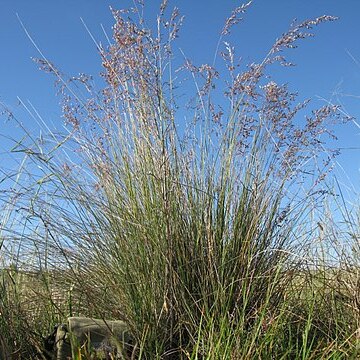Stiff, fine-leaved, greyish green, small, wiry, tussocks to c. 80 cm, from a narrow base packed with dead dry leaves; branching intravaginal; leaf-blades persistent. Leaf-sheath light brown, becoming dull grey-brown, coriaceous, smooth or slightly scabrid. Ligule c. 0.3 mm, a truncate minutely ciliate rim, abaxially with minute prickle-teeth. Leaf-blade 15-25-(35) cm, inrolled, c. 0.5 mm diam., abaxially usually finely scabrid, adaxially densely short-scabrid; margins finely scabrid, tip long, fine, acicular. Culm 30-75 cm, erect, internodes smooth to finely scabrid. Panicle 10-20 cm, contracted at first, later lax with spreading, slender, finely scabrid branches tipped by numerous spikelets. Spikelets (3.5)-4-5-(6.5) mm, 3-6-(8)-flowered, light green often purpled. Glumes ± unequal, narrow-lanceolate to narrow-ovate, acute to subacuminate, keels and sometimes internerves scabrid; lower 1.5-2 mm, 1-3-nerved, upper 2-2.5 mm, 3-nerved; margins minutely scabrid. Lemma c. 2.5 mm, 5-nerved, elliptic-oblong, ± closely pubescent on lower ½, usually with slightly longer hairs on keel and marginal nerves, tip obtuse, short-ciliate. Palea 2-2.5 mm, keels scabrid above and finely ciliolate in lower ½, interkeel pubescent especially in lower ½. Callus glabrous or with a few long hairs. Rachilla c. 0.5 mm, with a few short hairs. Lodicules 0.4-0.6 mm. Anthers 1.2-1.5 mm. Caryopsis c. 1.5 × 0.5 mm.
More
Caespitose, rarely stoloniferous perennial. Culms 9–55 (–80) cm high; mid-culm internodes glabrous or scabrous. Young shoots intravaginal. Leaves: basal sheaths with margins free or connate toward base, glabrous to scabrous, rarely pigmented; ligule 0.4–2 mm long, truncate, apically ciliolate, abaxially glabrous or pubescent; blade closely folded to involute, 2.5–22 (–60) cm long, 0.2–0.7 (–1) mm diam., flaccid, adaxially glabrous or scabrous to puberulous, abaxially scabrous to hispidulous. Panicles open, 1.5–11 (–20) cm long. Spikelets 2.8–6 (–7) mm long, with 3–7 bisexual florets. Glumes: lower glume 2.1–2.6 mm long, (1–) 3-nerved; upper glume 2–3 mm long, 3-nerved. Web not developed or rudimentary. Lemma (1.8–) 2.2–3.5 mm long, 5-nerved, usually puberulous in lower half, with longer hairs on midnerve or on all nerves; intercostal regions occasionally glabrous. Anthers 1.4–2 mm long.

